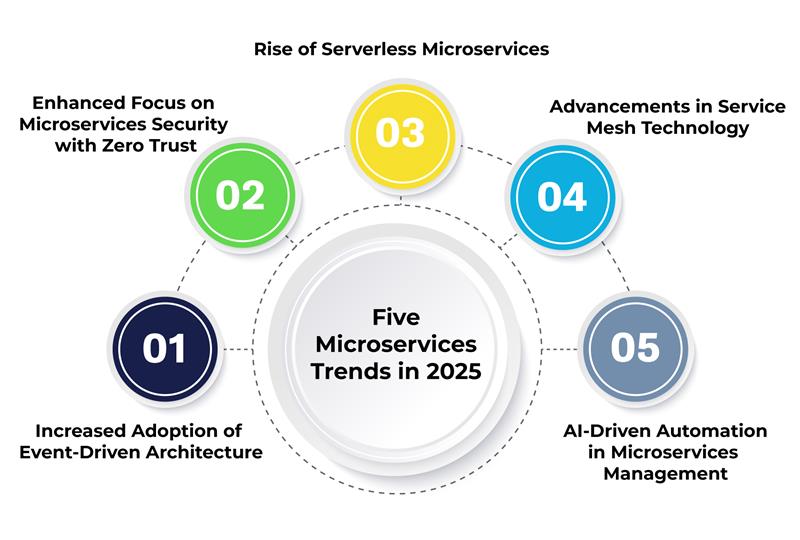In 2025, microservices continue to revolutionize software development, offering organizations agility, scalability, and efficiency. By decomposing monolithic applications into independent, manageable services, businesses can innovate rapidly and meet customer demands effectively. Here, we explore five key trends driving microservices adoption and transformation in 2025.

Microservices are becoming more responsive and dynamic, thanks to the growing implementation of event-driven architecture (EDA). EDA allows services to react in real time to events, improving responsiveness, scalability, and resource efficiency. This shift is critical for industries such as digital commerce, banking, and IoT, where instant reactions to events are paramount.
For instance, retailers leveraging EDA-powered microservices can provide real-time inventory updates during peak shopping seasons. This architecture ensures seamless customer experiences even during high-demand scenarios.
As microservices architectures grow, so does the attack surface for cyber threats. In 2025, the adoption of Zero Trust Security is becoming a key trend. This approach ensures that no component or user within a system is inherently trusted, mandating continuous verification for access.
The integration of DevSecOps practices further bolsters microservices security, embedding security measures into the development pipeline. By prioritizing security at every stage, businesses can protect their distributed architectures from evolving threats.
The serverless computing paradigm is reshaping how microservices operate, eliminating the need for businesses to manage underlying infrastructure. In 2025, more organizations are leveraging serverless frameworks, such as AWS Lambda and Azure Functions, to deploy microservices.
For example, serverless microservices allow startups to scale effortlessly, focusing on innovation rather than infrastructure management. This trend accelerates the adoption of microservices in industries with fluctuating workloads.
Service meshes are now an integral part of microservices architectures, streamlining service-to-service communication. Platforms like Istio, Linkerd, and Consul have matured, offering enhanced features such as observability, traffic management, and security.
In 2025, service mesh technology is evolving to become lighter and more efficient, addressing the challenges of overhead in resource-constrained environments. Businesses using service meshes gain operational insights and maintain consistent performance, even as their microservices ecosystem scales.
Artificial Intelligence (AI) is transforming how microservices are designed, deployed, and managed. In 2025, AI-driven automation is enabling proactive monitoring, anomaly detection, and predictive scaling.
By leveraging AI, businesses can streamline microservices management and ensure high availability. For example, healthcare providers using AI-enhanced microservices can guarantee consistent system performance, ensuring critical patient data is accessible at all times.
As organizations shift toward microservices, the benefits they reap extend beyond technical efficiency to include long-term business advantages. Here’s a look at how adopting microservices trends transforms businesses:
Microservices allow businesses to scale individual components independently, ensuring applications adapt seamlessly to changes in demand. For example:
This modularity ensures rapid adaptability to market trends, enabling businesses to innovate faster and stay competitive.
With trends like Zero Trust Security and DevSecOps, microservices ensure security is embedded into every layer of application development and deployment. Key benefits include:
For industries dealing with sensitive customer data, such as healthcare and banking, these security enhancements help meet regulatory compliance while safeguarding customer trust.
Microservices minimize operational expenses in several ways:
For startups or SMBs, this cost-effectiveness enables innovation without significant upfront investment in infrastructure.
Microservices improve the speed and reliability of customer-facing applications. Benefits include:
For example, streaming services using microservices can offer instant content recommendations, enhancing user satisfaction and retention.
Microservices isolate failures, ensuring that issues in one service don’t cascade across the entire application. With advancements in service mesh technology, businesses gain:
In industries where downtime can result in lost revenue or customer dissatisfaction, this resilience is a game-changer.
Microservices trends are driving innovation across multiple industries. Here’s how key sectors leverage these advancements:
E-commerce platforms face dynamic customer demands, especially during sales or holiday seasons. Microservices empower these businesses by:
For example, a global retailer can deploy serverless microservices to handle flash sales without worrying about infrastructure bottlenecks.
The financial sector benefits from microservices’ ability to enhance security, scalability, and operational efficiency. Key applications include:
Microservices also enable the rapid introduction of new features, such as digital wallets or AI-driven credit scoring systems, keeping banks competitive in the digital era.
Healthcare providers require robust, secure, and scalable systems to handle patient data and deliver quality care. Microservices trends are transforming healthcare in the following ways:
For instance, hospitals using microservices can ensure uninterrupted access to patient data during peak hours or emergencies, improving outcomes.
The IoT ecosystem, with its vast networks of connected devices, demands scalable and efficient microservices architectures. Key applications include:
From smart homes to industrial IoT, businesses can leverage microservices to deliver seamless, intelligent services.
Streaming platforms and content providers rely on microservices to deliver high-quality, personalized experiences to users. Benefits include:
Microservices also enable faster rollout of new features, such as multi-language support or interactive content, enhancing user engagement and loyalty.
By embracing microservices trends in 2025, industries are not only addressing immediate operational challenges but also laying the foundation for sustained growth and innovation. Whether you’re in e-commerce, healthcare, or IoT, microservices provide the tools to remain agile, secure, and customer-focused in today’s rapidly changing times.
The microservices trends of 2025 are set to redefine how businesses build, deploy, and scale applications. From enhanced scalability and agility to industry-specific innovations, adopting these trends can open significant growth opportunities for your organization. However, implementing and managing microservices requires the right expertise and a clear strategy.
At Charter Global, we specialize in delivering end-to-end microservices solutions tailored to your business needs. Whether you’re looking to modernize legacy systems, enhance security with Zero Trust principles, or leverage serverless and AI-driven automation, our experts are here to guide you every step of the way.
With over 30 years of experience, we combine deep technical expertise with a client-centric approach to deliver solutions that drive measurable results. Let us help you leverage the power of microservices to achieve operational excellence, scalability, and innovation.
Or email us at [email protected] or call +1 770-326-9933.